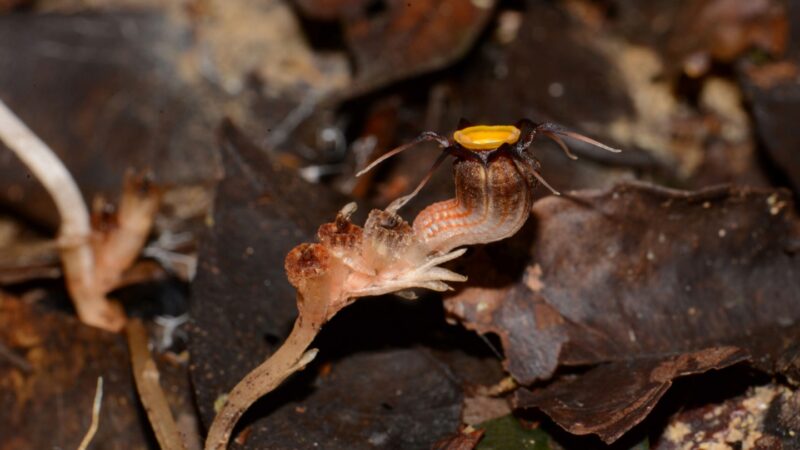In the weird world of “fairy lanterns,” there’s a new species to admire. The mysterious parasitic herb looks like something from another planet.
It’s a member of the genus Thismia. These tend to have pint-size flowers that come in wacky shapes and bright colors. Those weird blooms evolved to lure in fungus gnats and other pollinators. Researchers have just identified a never-before-seen species. It sprouts just above dense leaf litter in the rainforests of Malaysia.
The team shared its findings May 31 in PhytoKeys.
Finding the newest fairy lantern
By plant standards, Thismia are truly odd. Found in tropical forests, fairy lanterns spend most of their lives underground. So they don’t get much sunlight. That would be a problem for other plants that get their energy from the sun through photosynthesis. But fairy lanterns don’t do photosynthesis. Instead, they soak up nutrients from fungi in the soil.
Thismia do briefly erupt from the soil to flower. But being only a few centimeters tall, they can be easy to miss.
Explainer: How photosynthesis works
“The search for Thismia is not easy,” says Mat Yunoh Siti-Munirah. She works for the Forest Research Institute Malaysia in Kepong. “If [we’re] at the right time and in the right place, we can find it. But sometimes the visit remains unsuccessful, even after a few attempts.”
Siti-Munirah is a botanist. She catalogs the biodiversity of these parasitic plants in Malaysia. This Southeast Asian country sits just north of the equator. In 2020, one of her colleagues found an unusual fairy lantern there in Tengku Hassanal Wildlife Reserve. Later, a colleague spotted more of these plants in a different Malaysian park. Siti-Munirah traveled to the rainforests in these parks to confirm those reports.
In the lab, she and her team compared the newfound species with known fairy lanterns. The new ones, they realized, did not belong to any known type. So the researchers classified them as a new species: Thismia malayana.
A record of a new species is “like a birth certificate for plants,” Siti-Munirah says.
Do you have a science question? We can help!
Submit your question here, and we might answer it an upcoming issue of Science News Explores
The newly named fairy lanterns are brown and white. The flowers they grow have bright yellow centers. Around the blooms’ upper rim are several drab, tentacle-like prongs. Each bloom sort of looks like a squid — or even an alien.
Unlike its closest relatives, T. malayana has a distinct curve to the cup shape of its flower. The pollen-bearing structures inside it are a brilliant violet.
Siti-Munirah and her colleagues worry that the new species may be vulnerable to extinction. Both places where it’s been found are protected. However, Siti-Munirah’s survey turned up fewer than 10 individuals. Many more may lurk out of sight. Counting them is tricky since these plants mainly live under the ground.
Peculiar plants
There are around 100 known species of fairy lantern. They grow throughout tropical South America, Asia and Australia. But researchers haven’t studied them thoroughly. There’s two reasons for that, says Kenji Suetsugu. One is their “elusive nature.” The other is their tendency to live in specialized habitats. A botanist, Suetsugu works at Kobe University in Japan. He did not take part in the new research.
In recent years, some researchers have made a greater effort to explore less well-studied areas for fairy lanterns, he says. Scientists also are using new techniques to study these plants. For instance, they are analyzing the plant’s DNA.
This has led to the identification of multiple new species. One is the violet T. paradisiaca in Colombia. Another is the pale T. belumensis in Malaysia. Siti-Munirah and her colleagues first described T. belumensis in 2021.
Some recently spotted species of fairy lanterns haven’t been seen in decades. The trident-like T. neptunis of Borneo is one of them. It was recently found again after more than 150 years without any known sightings.
Suetsugu and his colleagues identified one Thismia species from a decades-old museum specimen. Because its only habitat was destroyed, the scientists thought it was extinct. But it was rediscovered in the wild just three years later.
This trend of discovery and rediscovery “reflects a growing interest and investment in understanding the biodiversity of these unique plants,” Suetsugu says. Learning more about how T. malayana grows and survives, he says, could help protect the plant’s future.




